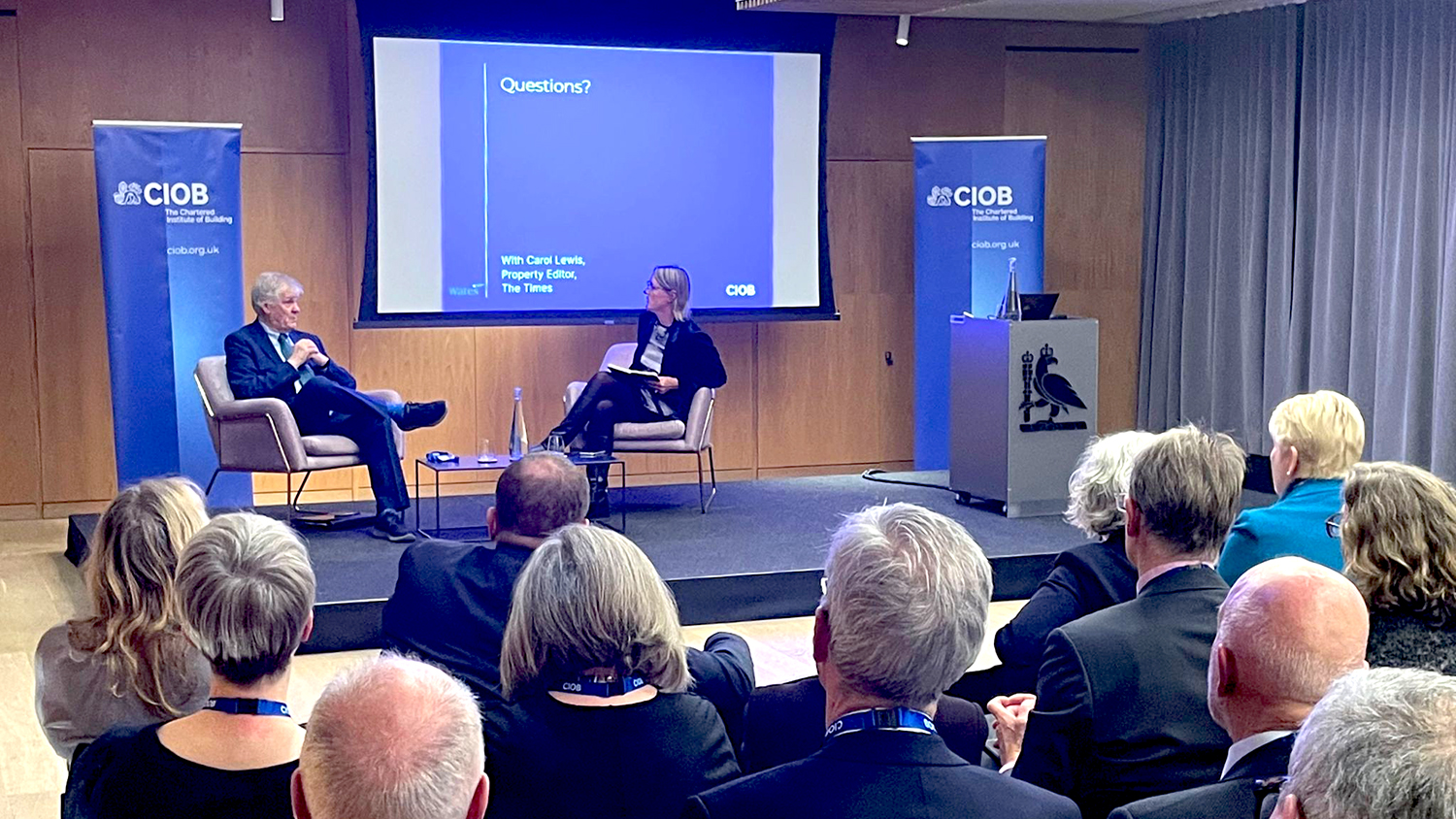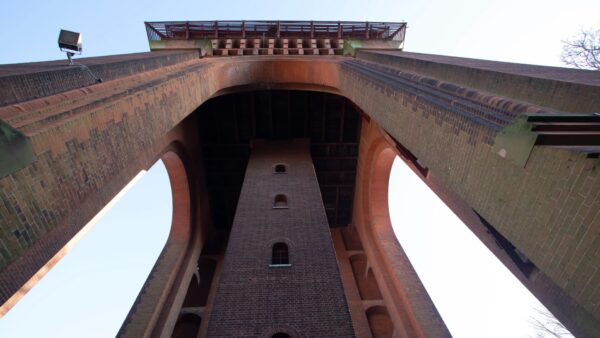
“Standards are not red tape. I think that’s a category error made by politicians. Standards [that state] if you do something, you should do it properly are not red tape.”
That was one of many compelling sound bites that Paul Morrell OBE delivered last week during his CIOB lecture, ‘How much longer? Why is change so difficult (and yet so necessary) in construction?’
Addressing an invited audience for an hour on 28 November, Morrell reviewed the industry’s issues with candour and humour via the prism of the government and industry’s response to the Grenfell tragedy, his ensuing review of the construction products testing regime, and his stint as government construction adviser.
Returning to standards, Morrell noted an absurdity: “We have a standard requiring the regulation of a bidet, but no standard for a fire door because Europe couldn’t agree on the standard!”
He added: “Standards are critical: standards for products, standards for testing, standards for people who do the testing, standards who do the verification of the people who do the testing, all the way up to UKAS.”
He noted that enforcement of standards and regulations is an issue: “There has been no enforcement at all. There has been not one single action under the Construction Product Regulations, not one. There has to be an enforcement system that works. People have to believe that they are not competing with people who are not bound by the same rules.”
Accident investigation
Morrell drew attention to another absurdity post-Grenfell by highlighting the role of accident investigation boards like the Air Accidents Investigation Branch or the Marine Accident Investigation Branch. He said: “We don’t learn our lessons. And there’s no machinery for learning lessons. I contrast [the construction industry’s position] with aviation. [The aviation industry] really tries to find out why a plane crashes and tries to stop it happening again.
“We have investigation boards (for aviation, rail and maritime) and I’m told they’re expensive. The Air Accidents Investigation Branch costs £4m a year; so far the Grenfell Inquiry has cost £150m and is going to top out at £200m. The police inquiry into Grenfell is £90m with 145 full-time police officers. Kensington & Chelsea has paid out £400m. The climate crisis will cost anything up to £17bn. But it’s too expensive to build a structure to monitor [construction accidents].”
What can clients do?
The event was chaired by Carol Lewis, property editor of The Times, who asked Morrell about the role of clients.
He answered: “First, they have to make up their mind about what they want and put a good team together. They must align that team.
“I’m really only interested in working in two ways: design and build, which I prefer to call ‘design, then build’; and construction management. Most of the stuff in between is fraught with danger.
“[Clients need to] be realistic about the price and the programme. [They must have] clarity and realism about what can be achieved, and the accountability that people are required to do what they say they will do.
“And the last two requirements for a client are: you should know what you can get out of the industry, otherwise they won’t give it to you. And you should also know what you can’t get.”
AI and checklists
Naturally technology featured in the lecture. Morrell dismissed visions of robots dominating the industry in the near future: “The dream of a building that will be designed by AI, delivered to site by drones and then constructed by a robot: I don’t think so. No time soon. But smaller stuff, yes. So, setting-out robots, by all means.”
He suggested a sensible role for artificial intelligence: “Nobody would take off in an aeroplane without going through checklists. Are we ready? Are we ready? If we want artificial intelligence to do anything for us, get it shout out ‘You’re not ready!’ quite early in the project.”
A BIM too far?
Among the CIOB lecture audience was Autodesk head of industry associations strategy Marek Suchocki, who asked whether the BIM movement (that Morrell helped launch when he drafted the Government Construction Strategy during his second term as government construction adviser) had aimed too high or too low?
Morrell responded: “If I think back at what hasn’t happened, I think [the BIM initiative] took off and went too high. The politicians loved the idea of Digital Built Britain, because politicians – mostly boys of course – love the idea of running the country like a train set.
“So suddenly, we were talking about Digital Built Britain, and we still didn’t know what BIM Level 3 looked like.
“I think it got away from us, the middle of the industry, when it went to Cambridge University. I think it got too complicated. The standards were effective, but a lot more complicated than the ones we envisioned very early on.
“And it became too much of an intellectual plaything. But I was entirely confident, very early, that it would be unstoppable because people would see the benefits.”
Comments
Comments are closed.












Great article. I particularly resonate with the point raised about the lack of enforcing standards. This absence of enforcement from the very top is a significant factor contributing to our industry’s ongoing struggle with information management standards & transformation in general. We also see impacts to competition…I could write a whole article on that!
I’m curious about our next steps though. Although we frequently discuss these matters, it seems we persist in the same direction day after day.
Take the BIM aspect, for instance. Early on, those of us on the front lines, well-versed in information management and modelling, sensed almost immediately that the BIM initiative was reaching too high and too far, too soon. The assumption that most projects already had the digital & information management basics in place and adhered to BS1192:2007 immediately led us astray. And our clients were also not ready for COBie nor did they have any enforced objective on them to digitise their facility/asset management contracts unless they were critical infrastructure reliant on data.
Despite our current situation, we have learnt nothing and still aiming too high. Numerous initiatives are underway on the same rocky path, often at public expense. Perhaps we should rein these initiatives in? This approach of ignoring the issues and creating new ones will inevitably require more education and problem-solving going forward, leaving people drowning in the rough seas of incomprehensible standards as those developing them continue sailing on without looking back. And if you challenge this status quo? Then you can find yourself overboard too.
I love the comment a “BIM to far”. It should be our motto. Still cant get Tekla or any of their experts to help me produce an IFC file that will pass my clients “BIM to far” requirements! Apparently it will be in their next release but until then, Solibri says no I’m told & there is no exceptions. We need a major rethink on all of this surely?
A great article that I think outlines the problems of introducing new methods and procedures, which is what the foundation of BS1192-2007 and BIM Level 2 were. it was fully understood when we started that BIM Level 2 was a staging point and that we should not progress to BIM Level 3 before 2 was fully embedded as business as usual. However the success of those early ideals was thrown away by those who wanted to turn this, as Paul suggests, into an intellectual plaything. the transition to ISO at the same time as setting up the CDBB did allow it to get away from us. A return to a more common sense application of simpler methods and procedures would allow the industry to adopt the simple methodologies that achieved the required saving and increased profit with reduced cost to the client. It is as stated far to complicated at present and the cost of implementation has become uneconomic, over complicated, as stated by Bill and the industry has not learned anything. Currently trying to achieve the unachievable.
This post and the comments that follow resonate with me immensely. When I used to work for the prison`s FM contractor, I was part of ministry`s working group, representing our FM services team. The working group, led by a BIM manager consultant disinvited me from all future groups because I kept challenging the status quo as John said. Back then and even now, we are using a system that doesn’t use COBie, we have a simple register that worked well and I would complain that when we got COBie files they would be a mess due to technical issues and process issues. So the 6 columns I only needed, I never got and we were always engaged late so couldn’t validate the data in COBie either. Although MOJ stakeholders used to agree with me, their lack of technical expertise meant they wouldn’t pipe up. The BIM consultant didn’t want to fix wider issues we all faced trying to move to BIM Level 2 and digital 4.0, she just wanted to quickly write pages of stuff she understood but no one else did. I haven’t been in the prison service for nearly 2 years, but the last one I supported had the exact same issues. So we had to go out and recover all the data ourselves from the subcontractors which took months. 10 years ago it was more efficient to get the data you needed than it is today!